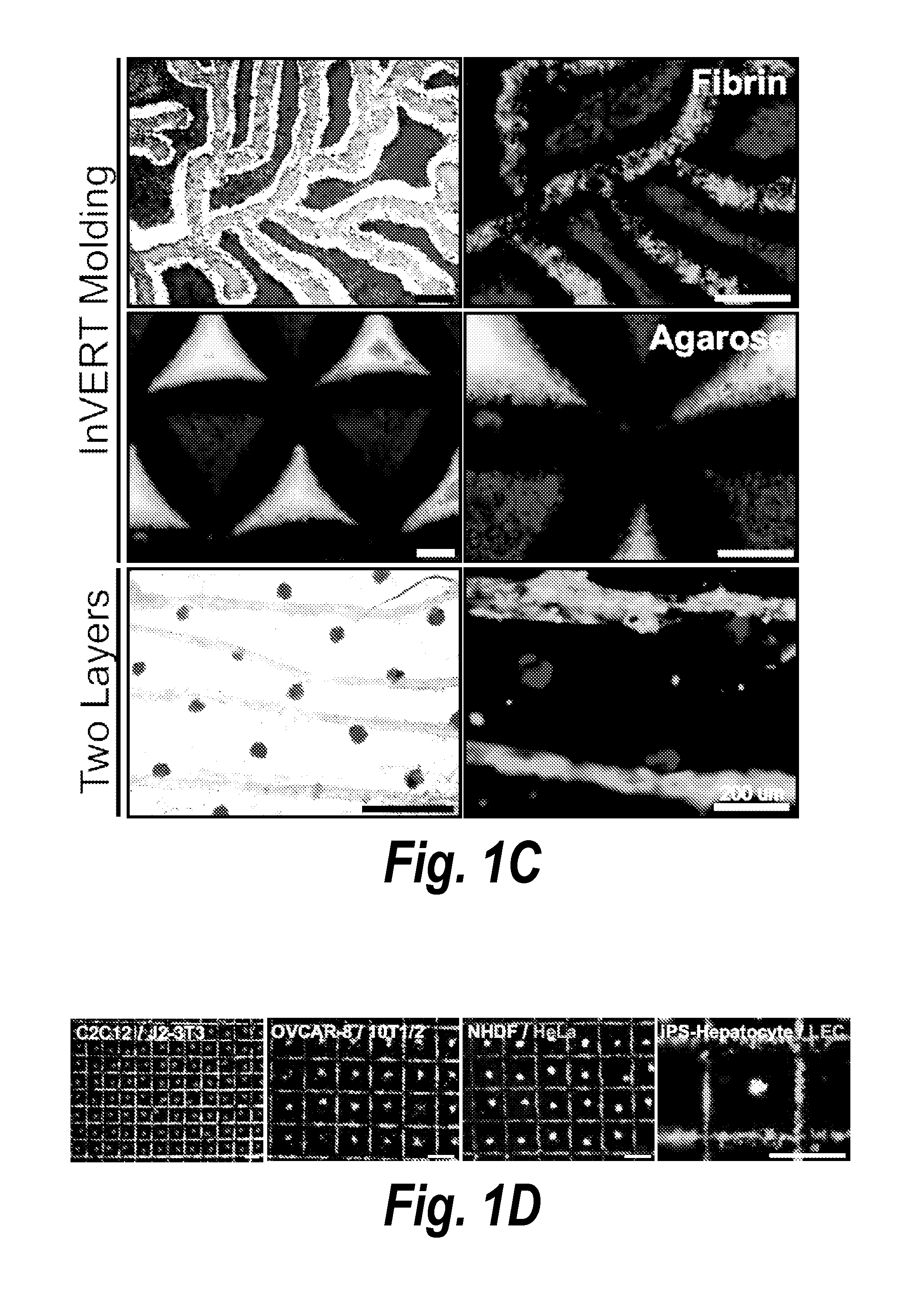Inverse patterning process for three-dimensional multi-compartmental micro-organization of multiple cell types
a multi-compartmental, cell-type technology, applied in the field of inverse patterning process for three-dimensional multi-compartmental micro-organization of multiple cell types, can solve the problems of poor printer resolution, printing time and specific material conductivity, low cellular density of microstructures, etc., and achieve the effect of rapid cell pattern
- Summary
- Abstract
- Description
- Claims
- Application Information
AI Technical Summary
Benefits of technology
Problems solved by technology
Method used
Image
Examples
example 1
Fabrication of Exemplary Inverse Patterned Constructs—InVERT Molding to Fabricate Engineered Tissues with Distinct Multicellular Micro-Compartments
[0107]The present invention features a process by which to encapsulate multiple cell types with distinct organization into a 3D hydrogel. (FIG. 1a). In particular, scalable, versatile, and rapid 3D multi-compartmental cellular patterning was achieved using an InVERT molding protocol (FIG. 1a). Topographic substrates were first produced containing microscale features and replica molded these substrates using poly(dimethylsiloxane) (PDMS) to create topographic ‘intaglio’ cell capture substrates with recessed ‘voids’. In this example, cells were first isolated in the micro-scale features of polydimethyl siloxane (PDMS) cell-capture substrate either in media or in a pre-polymer material. Cells patterned in media were then incubated overnight to allow formation of cell-cell junctions, e.g., cadherin and adhesion junctions, and then encapsulate...
example 2
Characterization of Multi-Compartmental Cellular Microorganization; High-Fidelity Microorganization of Multiple Cell Types Across Distinct Compartments
[0117]Existing scalable technologies do not allow interrogation of the functional impact of placement of multiple compartments in engineered tissues on the parenchyma. Endothelial cells of the vasculature modulate parenchymal tissue functions in both health and disease (Ding, B. S. et al. Nature 468, 310-315 (2010); Ding, B. S. et al. Cell 147, 539-553 (2011); Franses, J. W., et al. Sci Transl Med 3, 66ra65 (2011); and Aird, W. C. Pharmacol Rep 60, 139-143 (2008)) and play an ultimately non-dispensable role in oxygen and nutrient delivery. It was therefore desired to demonstrate the power of the InVERT molding technique by controlling the micro-scale patterning of distinct ‘parenchymal’ and ‘vascular’ compartments in 3D engineered liver tissue. Primary rat hepatocytes were seeded in microwell patterning substrates, incubated overnight...
example 3
Hierarchical Modulation of Microstructure and Multi-Cellular Composition within a Given Compartment
[0119]Complex tissues are hierarchically organized across multiple length-scales and contain numerous cell types. In particular, such complex tissues are hierarchically organized such that each tissue compartment is further organized at both the microstructural and multicellular level. Thus, it was next examined whether additionally fine-tuning of the microstructure and multi-cellular composition within a tissue given compartment could be accomplished using InVERT molding. Specifically, we refined the hepatic compartment produced during the initial Intaglio-Void-Embed portion of the InVERT molding protocol without adding a second cell population (‘relief’ phase). To test whether the microstructure of aggregates in the hepatic compartment could be reproducibly modulated, primary rat hepatocytes were seeded in microwell patterning substrates at densities of 10-500 cells per microwell, in...
PUM
| Property | Measurement | Unit |
|---|---|---|
| diameter | aaaaa | aaaaa |
| diameter | aaaaa | aaaaa |
| diameter | aaaaa | aaaaa |
Abstract
Description
Claims
Application Information
 Login to View More
Login to View More - R&D
- Intellectual Property
- Life Sciences
- Materials
- Tech Scout
- Unparalleled Data Quality
- Higher Quality Content
- 60% Fewer Hallucinations
Browse by: Latest US Patents, China's latest patents, Technical Efficacy Thesaurus, Application Domain, Technology Topic, Popular Technical Reports.
© 2025 PatSnap. All rights reserved.Legal|Privacy policy|Modern Slavery Act Transparency Statement|Sitemap|About US| Contact US: help@patsnap.com



